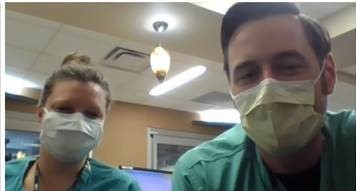
Note: This story is part of an ongoing series, "Pharmacists on the Front Lines," which highlights the work of CU pharmacists in the COVID-19 battle.
Even the most well-stocked hospital in the U.S. is not immune to an all-too-familiar consequence of the COVID-19 pandemic: drug shortages. As the FDA monitors the drug supply chain contributing to the supply disruptions and shortage of drug products, pharmacists in COVID-19 units are using their drug expertise to develop innovative solutions.
“It’s a different illness,” says Dr. Scott Mueller, critical care pharmacist and associate professor at the CU Anschutz Skaggs School of Pharmacy and Pharmaceutical Sciences. “These (COVID-19) patients are extremely, critically ill when they get to us in the ICU. They are completely hyper-inflamed. They are hyper-coagulable. They have a lot of needs from a mechanical ventilation standpoint.”
At the start of the coronavirus outbreak it was the availability of those critical ventilators that health care workers were concerned about. Fortunately, that reality has not played out at the University of Colorado Hospital, where Mueller serves and teaches. Instead, it is the shortage of key drugs that is proving a challenge.
Mueller explains, “From a pharmacy standpoint, one of the things that we’re seeing is the need for sedation and analgesia that are higher than we’ve seen in decades. For example, a lot of the first line agents that we are used to using just aren’t available. So, we’re blowing through what we do have at very high doses and going on to second line agents or double, triple therapies.”
One of the unique components of treating COVID-19 patients is that when their respiratory problems become severe, they must rely on a ventilator to essentially breath for them. That’s where the need for unprecedented levels of sedation come into play.
As second-year pharmacy resident Dr. Mary Bradley explains, many of the patients she treats have to be medically paralyzed while on ventilation. The high doses of drugs required to accomplish this present a delicate balancing act for the ICU pharmacists.
“One of the things that I’m doing the most is helping the medical team to optimize sedation and analgesia in order to make the patient comfortable whenever they’re ventilated," she said. "We are pulling some different tools out of our toolbox and that’s one of the helpful things that pharmacists are doing right now. We’re helping to dose those therapies to ensure we’re doing the right thing for the patients in terms of sedation while staying safe.”
For Doctors of Pharmacy treating COVID-19, staying safe is something that they must not only prioritize for their patients, but also for themselves and their family. Since Dr. Mueller’s wife is going into her third trimester of pregnancy, he has developed a system to limit the chances that he could spread the virus to her. “I’m quarantined in the basement. (After working at the hospital) I shower at the school. I put everything in plastic bags. I go straight downstairs to the basement. And then my wife provides me my prisoner meals on the landing are,” he says with a chuckle. “I grab them and eat and yell up when I need something.”
When asked how he and others in the ICU maintain their stamina, Mueller replied, “You reach down deep and you find that extra part to get your stuff done and make sure you’re providing an optimal education experience for the students, that you’re providing good care for the patients, and that you’re able to teach in the hospital as well. And when you come out of the back end of this you don’t forget that at some point you’re going to have to look back and say, ‘How do we do better the next time?’ So you can improve for the next patient that comes in.”
For behind-the-scenes content, watch the video interview here:
.png)

